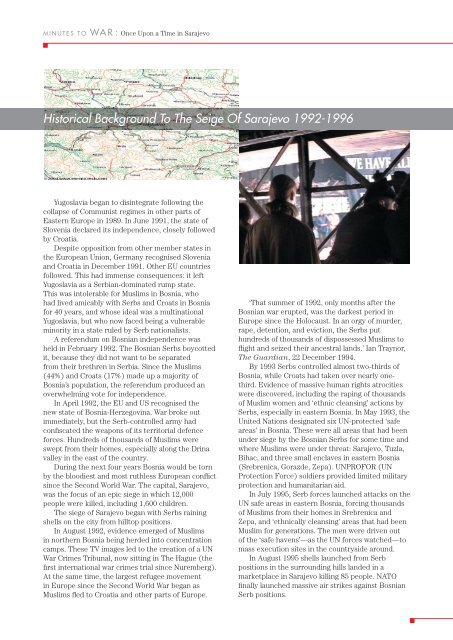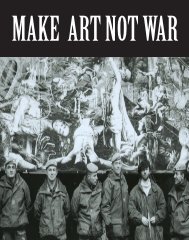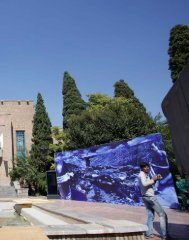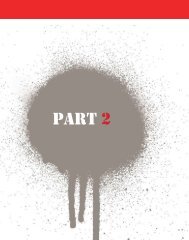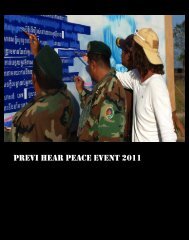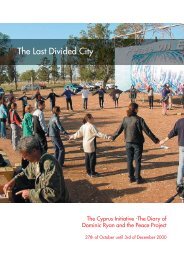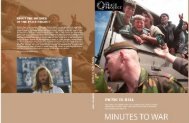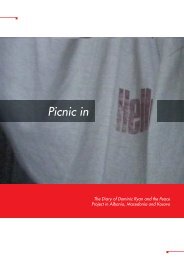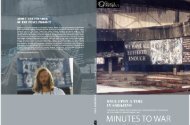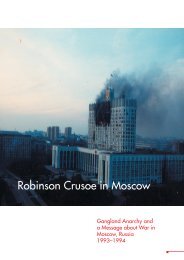You also want an ePaper? Increase the reach of your titles
YUMPU automatically turns print PDFs into web optimized ePapers that Google loves.
M I N U T E S T O WA R : Once Upon a Time in Sarajevo<br />
Historical Background To The Seige Of Sarajevo 1992-1996<br />
Yugoslavia began to disintegrate following the<br />
collapse of Communist regimes in other parts of<br />
Eastern Europe in 1989. In June 1991, the state of<br />
Slovenia declared its independence, closely followed<br />
by Croatia.<br />
Despite opposition from other member states in<br />
the European Union, Germany recognised Slovenia<br />
and Croatia in December 1991. Other EU countries<br />
followed. This had immense consequences: it left<br />
Yugoslavia as a Serbian-dominated rump state.<br />
This was intolerable for Muslims in Bosnia, who<br />
had lived amicably with Serbs and Croats in Bosnia<br />
for 40 years, and whose ideal was a multinational<br />
Yugoslavia, but who now faced being a vulnerable<br />
minority in a state ruled by Serb nationalists.<br />
A referendum on Bosnian independence was<br />
held in February 1992. The Bosnian Serbs boycotted<br />
it, because they did not want to be separated<br />
from their brethren in Serbia. Since the Muslims<br />
(44%) and Croats (17%) made up a majority of<br />
Bosnia’s population, the referendum produced an<br />
overwhelming vote for independence.<br />
In April 1992, the EU and US recognised the<br />
new state of Bosnia-Herzegovina. War broke out<br />
immediately, but the Serb-controlled army had<br />
confiscated the weapons of its territorial defence<br />
forces. Hundreds of thousands of Muslims were<br />
swept from their homes, especially along the Drina<br />
valley in the east of the country.<br />
During the next four years Bosnia would be torn<br />
by the bloodiest and most ruthless European conflict<br />
since the Second World War. The capital, Sarajevo,<br />
was the focus of an epic siege in which 12,000<br />
people were killed, including 1,600 children.<br />
The siege of Sarajevo began with Serbs raining<br />
shells on the city from hilltop positions.<br />
In August 1992, evidence emerged of Muslims<br />
in northern Bosnia being herded into concentration<br />
camps. These TV images led to the creation of a UN<br />
War Crimes Tribunal, now sitting in The Hague (the<br />
first international war crimes trial since Nuremberg).<br />
At the same time, the largest refugee movement<br />
in Europe since the Second World War began as<br />
Muslims fled to Croatia and other parts of Europe.<br />
‘That summer of 1992, only months after the<br />
Bosnian war erupted, was the darkest period in<br />
Europe since the Holocaust. In an orgy of murder,<br />
rape, detention, and eviction, the Serbs put<br />
hundreds of thousands of dispossessed Muslims to<br />
flight and seized their ancestral lands.’ Ian Traynor,<br />
The Guardian, 22 December 1994.<br />
By 1993 Serbs controlled almost two-thirds of<br />
Bosnia, while Croats had taken over nearly onethird.<br />
Evidence of massive human rights atrocities<br />
were discovered, including the raping of thousands<br />
of Muslim women and ‘ethnic cleansing’ actions by<br />
Serbs, especially in eastern Bosnia. In May 1993, the<br />
United Nations designated six UN-protected ‘safe<br />
areas’ in Bosnia. These were all areas that had been<br />
under siege by the Bosnian Serbs for some time and<br />
where Muslims were under threat: Sarajevo, Tuzla,<br />
Bihac, and three small enclaves in eastern Bosnia<br />
(Srebrenica, Gorazde, Zepa). UNPROFOR (UN<br />
Protection Force) soldiers provided limited military<br />
protection and humanitarian aid.<br />
In July <strong>1995</strong>, Serb forces launched attacks on the<br />
UN safe areas in eastern Bosnia, forcing thousands<br />
of Muslims from their homes in Srebrenica and<br />
Zepa, and ‘ethnically cleansing’ areas that had been<br />
Muslim for generations. The men were driven out<br />
of the ‘safe havens’—as the UN forces watched—to<br />
mass execution sites in the countryside around.<br />
In August <strong>1995</strong> shells launched from Serb<br />
positions in the surrounding hills landed in a<br />
marketplace in Sarajevo killing 85 people. NATO<br />
finally launched massive air strikes against Bosnian<br />
Serb positions.


